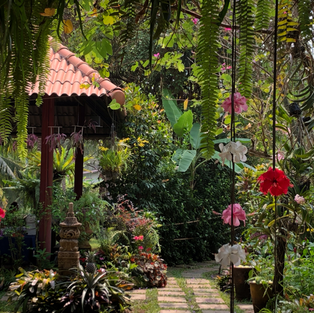When I started planning the Thailand section of our journey around the world, I thought we would take the train from Chang Mai to Bangkok rather than flying so we could see some of the countryside. However, during my research, I came across an advertisement for a two day overland trip with several stops to see temples and historic sites along the way, so I booked that instead. It turned out to be a great way to learn about the history, culture and religion of Thailand -- the land of many, many Buddhas.

I wasn’t sure what to expect -- I thought we might be part of small group tour but it turned out to be a personalized tour just for us. We were picked up early in the morning by Kate, our guide, and our driver, whose name was Seven, in a very new and luxurious van. This was the fanciest, most comfortable vehicle we had been in since we started our journey. We sat back to enjoy the ride.

Lampang - Wat Phra That
Our first stop was in Lampang at Wat Phra That, a temple that is famous for housing a relic of the Buddha. The relic, believed to be bone and ashes that were collected after he was cremated, are sealed in the pointed dome, or chedi, behind us. However, another legend has it that Buddha himself visited the site and donated one of his hairs to be sealed in the chedi.

The chedi is surrounded by a carpeted walkway where worshipers walk around it three times while praying and meditating. It is also surrounded by many small temples and shrines housing beautiful golden statues where people leave offerings.
In one small temple, we were startled by the presence of three monks. It took a minute to realize that they were sculpted from wax. Very eerie!

One shrine was protected by a cage. Kate said that the Buddha in it was discovered sealed inside when renovations occurred and is believed to be one of the oldest.

We also saw a beautiful emerald Buddha in Lampang.

As we explored these shrines Kate explained much about the religion and the customs of the local people. It seems that, like with many religions, a certain amount of superstition and wishful thinking is incorporated into the belief system. The people make offerings of animal statues (chickens are particularly popular) and do “good deeds” such as propping up the branches of the aging sacred bodhi trees or tying colorful scarves around the trunks in hopes of having wishes granted.
The shrines are protected by images of snakes (naga) and birds (garuda). They appear around doorways and on rooftops.
On the back wall of one temple is a beautiful mural depicting the birth of Buddha. According to legend, the birth occurred at the foot of a tree and the child immediately began to walk. He took seven steps and at each step a lotus flower appeared.

After a stop for a delicious lunch, we drove on to Sukhothai Historical Park, a UNESCO World Heritage Site. This was the first capital city of the Kingdom of Siam and dates to about 800 years ago. The buildings are mostly in ruins but there are remnants of some impressive temples and several large Buddha statues still intact. There were very few visitors that day so we had a peaceful walk through this ancient city and imagined what life might have been like at the time.
We spent the night in a comfortable hotel in Phitsanulok, a fairly large city. The next day -- lots more Buddhas. The first stop of the morning was a Buddha foundry where you can have a statue made in many styles and poses.

Kate explained that the features and styles of the Buddha statues changed over the years depending on who was ruling the country at the time. For example, when Cambodia occupied the area, the features of the statues were quite different than during the Burmese invasion. Also, there are sitting Buddhas, reclining Buddhas, and standing Buddhas. And, there is a different Buddha for each day of the week which are described here. If you find out what day of the week you were born, you will see what characteristics are related to that day.
We saw statues and body parts of all sizes in various states of preparation, including a very large Buddha that was being hoisted onto a truck for transport to its final resting place. Apparently, it will be assembled and finished at its destination.
Our next stop was Wat Phra Si Rattana Mahathat, a royal temple founded in 1357. It is home to a famous golden Buddha that many consider to be the most beautiful statue in the country.

This Buddha is highly revered, making this temple an important pilgrimage site for Thai people. While we were there, a large university group was assembling for a photo shoot in front of the famous Buddha.

This royal temple is also the site of another famous Buddha image, a standing Buddha in front of a corn cob type shrine, or prang, that houses relics of the Buddha.

Back on the road, we headed south again. We were getting hungry for lunch, when the driver pulled off the highway onto a nondescript dirt road in a rural area. We were wondering where we were headed now but it turned out to be our lunch spot. From the parking lot, they led us through a gorgeous garden to our private table by a pond.
A little feast appeared before us and we enjoyed a delicious, restful stop.
After lunch, we headed to Ayutthaya, the second capital city of the Kingdom of Siam after Sukhothai and now another UNESCO World Heritage Site that dates from 1350. At the entrance is a model of what it would have looked like before the Burmese invaded and destroyed it in 1767.

The historic park, with many temples and ruins, covers a large area where one could spend many hours exploring. However, it was a hot day and we had already seen many temples and Buddhas so we focused on a few highlights.
There were many decapitated heads that had been salvaged from the wreckage and propped against the walls. They reminded us of the moais on Easter Island.

One head had somehow become embedded in the roots of a bodhi tree creating an eerie work of art.

From Ayutthaya, we drove into Bangkok, an immense city of ten million people, and somehow found our hotel. It turned out to be a very pleasant little place in a fairly quiet side street. The next couple of days brought a few surprises as we explored Bangkok with some local guides.


















































Comments